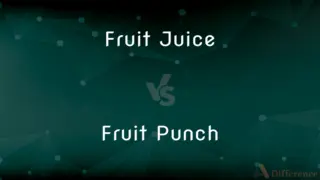Reticulate Venation vs. Parallel Venation — What's the Difference?
By Tayyaba Rehman — Published on December 21, 2023
Reticulate Venation features a branching network of veins in leaves, typical in dicots. Parallel Venation displays straight, side-by-side veins, common in monocots.

Difference Between Reticulate Venation and Parallel Venation
Table of Contents
ADVERTISEMENT
Key Differences
In the botanical world, Reticulate Venation and Parallel Venation are distinct patterns that describe the arrangement of veins within leaves. Reticulate Venation, as its name suggests, forms a network or a web-like pattern. In this type, the larger veins branch out into smaller veins, creating a mesh-like appearance. This kind of venation is predominantly seen in dicotyledonous plants.
Parallel Venation, on the other hand, is characterized by veins that run side-by-side, parallel to each other, without branching out extensively. This form of venation runs from the base of the leaf to the tip without much divergence. It's a characteristic feature of monocotyledonous plants.
One of the primary roles of veins in leaves is to transport nutrients and water. In Reticulate Venation, the interconnected network ensures efficient distribution across the entire leaf surface. In Parallel Venation, the straightforward pathway allows for a direct channel of transport from the base to the tip of the leaf.
An interesting aspect is how these venation patterns relate to the evolutionary history of plants. The Reticulate Venation pattern is believed to offer more flexibility and adaptability to various environments. In contrast, Parallel Venation provides a structured and consistent arrangement which can be crucial for some monocots in their specific habitats.
Comparison Chart
Definition
A branching network of veins
Straight, side-by-side veins
ADVERTISEMENT
Plant Type
Common in dicots
Common in monocots
Appearance
Web-like or mesh pattern
Parallel lines without much divergence
Evolutionary Significance
Offers adaptability and flexibility
Structured and consistent arrangement
Function
Efficient distribution across the entire leaf surface
Direct channel from the base to the tip
Compare with Definitions
Reticulate Venation
Mesh-like interconnected veins in leaves.
The intricate Reticulate Venation is evident in the hibiscus leaf.
Parallel Venation
Veins in leaves that run side by side.
The grass blade displays a clear Parallel Venation.
Reticulate Venation
A network-like vein arrangement in leaves.
The oak leaf displays a clear Reticulate Venation pattern.
Parallel Venation
Uniformly aligned veins without much divergence.
The corn plant exhibits Parallel Venation in its elongated leaves.
Reticulate Venation
Vein pattern where main veins branch into smaller ones.
Observing the maple leaf, one can see the Reticulate Venation.
Parallel Venation
Straight vein pattern without extensive branching.
Observing the bamboo leaf, one notices the Parallel Venation.
Reticulate Venation
Webbed venation characteristic of dicots.
The rose plant, being a dicot, showcases Reticulate Venation in its leaves.
Parallel Venation
Characteristic venation of monocots.
The lily, being a monocot, showcases Parallel Venation in its leaves.
Reticulate Venation
Veins that diverge into numerous smaller veins.
The mulberry leaf's Reticulate Venation adds to its beauty.
Parallel Venation
Veins that extend directly from base to tip.
The banana leaf's Parallel Venation gives it strength and structure.
Common Curiosities
What does Reticulate Venation look like?
Reticulate Venation appears as a network or web-like pattern in leaves.
How does Reticulate Venation benefit the leaf?
Reticulate Venation ensures efficient nutrient and water distribution across the leaf.
How can I identify Parallel Venation?
In Parallel Venation, veins run side-by-side without branching out extensively.
Is Reticulate Venation more common in certain plants?
Yes, Reticulate Venation is typically found in dicotyledonous plants.
Are monocots associated with a particular venation type?
Yes, monocotyledonous plants usually display Parallel Venation.
Why is Parallel Venation straight and uniform?
It provides a direct transport channel from the base to the tip of the leaf.
How does venation contribute to the leaf's structure?
Veins, whether in Reticulate or Parallel Venation, provide support and rigidity to the leaf.
Is venation visible in all leaves?
While venation is present in all leaves, it might not always be visibly distinct.
Can environmental factors influence venation patterns?
Genetic factors primarily determine venation, but environmental factors might influence leaf morphology overall.
Are there exceptions to these venation patterns?
While these patterns are characteristic, there can be exceptions or variations in nature.
Can venation patterns help in plant identification?
Yes, venation patterns like Reticulate or Parallel can be clues to whether a plant is a dicot or monocot.
Does Reticulate Venation offer evolutionary advantages?
Its adaptability and flexibility might offer advantages in diverse environments.
Can Parallel Venation be found in large leaves?
Yes, many large leaves, like those of the banana plant, exhibit Parallel Venation.
Are there intermediate venation patterns between Reticulate and Parallel?
While these are two primary types, variations and intermediate patterns can exist.
Do venation patterns affect the leaf's color or texture?
While venation contributes to texture, leaf color is more influenced by pigments.
Share Your Discovery

Previous Comparison
Fruit Juice vs. Fruit Punch
Next Comparison
Flat Characters vs. Round CharactersAuthor Spotlight
Written by
Tayyaba RehmanTayyaba Rehman is a distinguished writer, currently serving as a primary contributor to askdifference.com. As a researcher in semantics and etymology, Tayyaba's passion for the complexity of languages and their distinctions has found a perfect home on the platform. Tayyaba delves into the intricacies of language, distinguishing between commonly confused words and phrases, thereby providing clarity for readers worldwide.











































